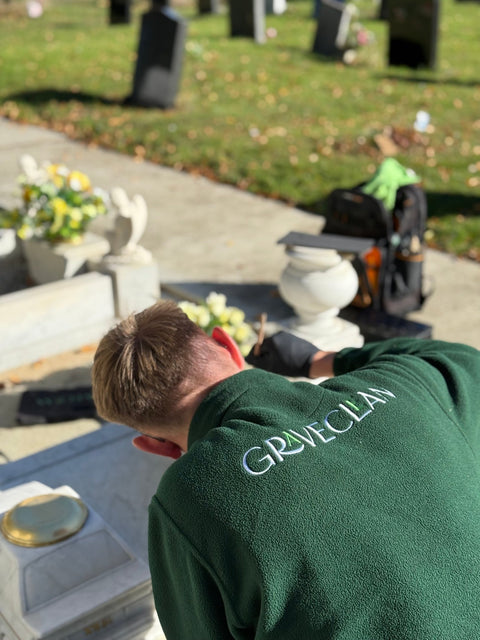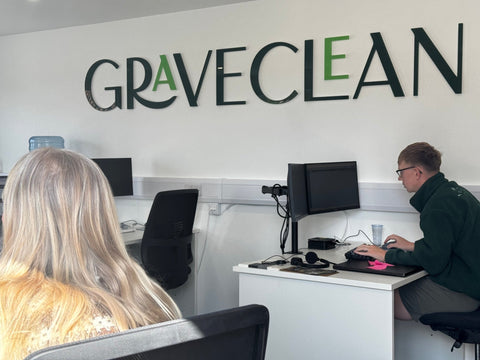When families want to restore a headstone, they’re often faced with two very different approaches:
-
Chemical cleaning, which gently lifts staining and biological growth, and
-
Manual resurfacing or sanding, a method traditionally used by some stone masons.
While both can make a memorial look “cleaner,” the long-term results — and the effect on the stone itself — are worlds apart.
At GraveClean, we specialise in chemical, conservation-approved cleaning.
We’re often called in after families regret choosing the sanding route, because while it may have made the stone look bright at first, it has also removed valuable surface detail and weakened the engraving.
The Difference Between Cleaning and Removing the Surface
Chemical cleaning, when performed professionally, removes contamination, not stone.
We use a pH-neutral, non-acidic solution that penetrates surface growth such as moss, algae, and lichen, and breaks it down gently — without altering the composition or patina of the memorial.
By contrast, manual cleaning — often called sanding, grinding, or stone resurfacing — physically removes the outer layer of the headstone to reveal a “fresh” surface underneath.
This process can strip millimetres off the face of the stone, causing:
-
Thinning and fading of inscriptions and carvings,
-
Exposure of new open pores that accelerate weathering,
-
Permanent loss of the original finish and fine detail.
What may appear as a bright, new surface actually comes at the cost of irreversible damage.
Why Stone Masons Often Remove the Headstone Entirely
Some traditional masons still take memorials away to their workshops for sanding or mechanical cleaning. While this may sound thorough, it often causes unnecessary disruption and risk:
-
Long downtime: Once removed, the grave cannot immediately be refitted. The ground must settle for around six months before reinstallation can take place.
-
Increased handling risks: Transporting and re-fixing old memorials raises the chance of cracks, alignment issues, or damage to foundations.
-
Loss of authenticity: Many memorials are historic. Sanding erases the stone’s natural ageing and historical value — something that can never be replaced.
The Truth About Chemical Cleaning and “Etching”
Some sources claim that chemical cleaning can “etch” or damage headstones if done excessively. While this can be true with acidic or unregulated products, it is not the case with properly formulated, conservation-grade cleaners like those used by GraveClean.
Our Head of Product Technicals directly verifies that there is no scientific evidence of pH-neutral biocides causing etching — even after repeated use — when applied in correct concentrations.
In reality, headstones sit in cemeteries for decades without being touched, and the few times they are cleaned professionally (often once every 5–10 years) pose no measurable risk to the stone surface whatsoever.
Laboratory testing and field data confirm that GraveClean’s proprietary cleaner has zero etching effect on both marble and granite — even under prolonged exposure simulations.
So, while overuse of harsh chemicals is a valid concern in theory, it simply doesn’t apply to the approved, non-acidic formulations that we use and supply.
Why GraveClean’s Method Is Conservation-Approved
GraveClean follows churchyard and council conservation standards, ensuring every project:
-
Avoids sanding, grinding, or abrasive removal,
-
Uses only biodegradable, pH-neutral products,
-
Employs soft brushes and low-pressure rinsing,
-
Includes risk assessments and stability checks before any work begins,
-
Preserves both the appearance and the historical integrity of each memorial.
Our methods are compliant with the War Memorials Trust, NAMM, and heritage conservation best practices.
The Results Speak for Themselves
Our gentle cleaning process restores the stone’s original character without removing a single layer of material. The natural colours and engraved names reappear, but the texture, tone, and history remain untouched.
Families are consistently amazed by how much life can be brought back to a headstone — safely, respectfully, and without the destructive consequences of sanding.
The Safer, Smarter Choice
Choosing between sanding and chemical cleaning is really about deciding between cosmetic quick fixes and long-term preservation.
Our work protects not only the memorial’s appearance, but also its structural integrity, inscriptions, and sentimental value for generations to come.
If you’re considering having a memorial restored, ask whether the company uses non-abrasive, conservation-grade techniques.




Comments (0)
There are no comments for this article. Be the first one to leave a message!